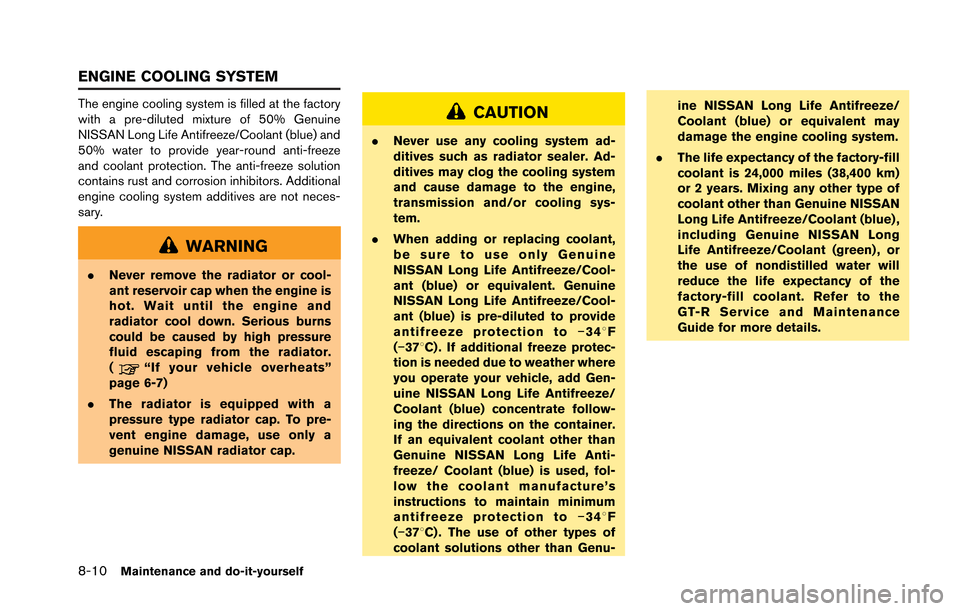Page 277 of 346

8-10Maintenance and do-it-yourself
The engine cooling system is filled at the factory
with a pre-diluted mixture of 50% Genuine
NISSAN Long Life Antifreeze/Coolant (blue) and
50% water to provide year-round anti-freeze
and coolant protection. The anti-freeze solution
contains rust and corrosion inhibitors. Additional
engine cooling system additives are not neces-
sary.
WARNING
.Never remove the radiator or cool-
ant reservoir cap when the engine is
hot. Wait until the engine and
radiator cool down. Serious burns
could be caused by high pressure
fluid escaping from the radiator.
(
“If your vehicle overheats”
page 6-7)
. The radiator is equipped with a
pressure type radiator cap. To pre-
vent engine damage, use only a
genuine NISSAN radiator cap.
CAUTION
.Never use any cooling system ad-
ditives such as radiator sealer. Ad-
ditives may clog the cooling system
and cause damage to the engine,
transmission and/or cooling sys-
tem.
. When adding or replacing coolant,
be sure to use only Genuine
NISSAN Long Life Antifreeze/Cool-
ant (blue) or equivalent. Genuine
NISSAN Long Life Antifreeze/Cool-
ant (blue) is pre-diluted to provide
antifreeze protection to −348 F
(−378C) . If additional freeze protec-
tion is needed due to weather where
you operate your vehicle, add Gen-
uine NISSAN Long Life Antifreeze/
Coolant (blue) concentrate follow-
ing the directions on the container.
If an equivalent coolant other than
Genuine NISSAN Long Life Anti-
freeze/ Coolant (blue) is used, fol-
low the coolant manufacture’s
instructions to maintain minimum
antifreeze protection to −348 F
(−378C) . The use of other types of
coolant solutions other than Genu- ine NISSAN Long Life Antifreeze/
Coolant (blue) or equivalent may
damage the engine cooling system.
. The life expectancy of the factory-fill
coolant is 24,000 miles (38,400 km)
or 2 years. Mixing any other type of
coolant other than Genuine NISSAN
Long Life Antifreeze/Coolant (blue) ,
including Genuine NISSAN Long
Life Antifreeze/Coolant (green) , or
the use of nondistilled water will
reduce the life expectancy of the
factory-fill coolant. Refer to the
GT-R Service and Maintenance
Guide for more details.
ENGINE COOLING SYSTEM
Page 278 of 346

CHECKING ENGINE COOLANT LE-
VEL
Check the coolant levelin the reservoir when
the engine is cold. If the coolant level is below
the MIN level
*2, open the reservoir cap
(pressure type)
*Band add coolant up to
between the MAX and MIN level
*3. If the
reservoir is empty, open the radiator filler cap
*Aand check the coolant level in the radiator when
the engine is cold. If there is insufficient
coolant in the radiator, fill the radiator with
coolant up to the filler opening and also add it to
the reservoir up to between the MAX and MIN
level
*3.
This vehicle contains Genuine NISSAN Long
Life Antifreeze/Coolant (blue). The life expec-
tancy of the factory-fill coolant is 24,000 miles
(38,400 km) or 2 years. Mixing any other type of
coolant or the use of non-distilled water will
reduce the life expectancy of the factory-fill
coolant. Refer to the GT-R Service and Main-
tenance Guide for more details.
If the cooling system frequently requires
coolant, have it checked by a GT-R certified
NISSAN dealer.
Check that the level of coolant is between MAX
and MIN on the pressurized radiator reservoir. If
the level is below the midpoint, the amount of coolant circulating may be insufficient for max-
imum vehicle performance, possibly causing
engine overheating or other trouble.
If it is difficult to determine the midpoint between
MAX and MIN, remove the coolant reservoir cap
and look inside through the opening to check
that the coolant level is above the divider
*3between the top half and bottom half of the
pressurized coolant reservoir.
NOTICE
.
The coolant reservoir is equipped
with a pressure type cap, and the
radiator is equipped with a non-
pressure type cap. Do not switch
the radiator filler cap and the cool-
ant reservoir cap. Doing so will
cause substandard cooling perfor-
mance and overheating.
. If you have added only water as the
coolant in an emergency, change it
to a coolant mixture ratio specified
as soon as possible.
Maintenance and do-it-yourself8-11
Page 279 of 346

8-12Maintenance and do-it-yourself
CHANGING ENGINE COOLANT
If major cooling system repairs are required,
contact a GT-R certified NISSAN dealer. The
service procedures can be found in the appro-
priate NISSAN Service Manual.
Improper servicing can result in reduced
heater performance and engine overheat-
ing.
WARNING
.To avoid the danger of being
scalded, never change the coolant
when the engine is hot.
. Never remove the radiator filler cap
and the coolant reservoir cap when
the engine is hot. Serious burns
could be caused by high pressure
fluid escaping from the radiator and
reservoir.
. Avoid direct skin contact with used
coolant. If skin contact is made,
wash thoroughly with soap or hand
cleaner as soon as possible.
. Keep coolant out of reach of chil-
dren and pets. Engine coolant must be disposed of properly.
Check your local regulations.
CHECKING ENGINE OIL LEVEL
1. Park the vehicle on a level surface and apply
the parking brake.
2. Run the engine until it reaches operating temperature.
3. Turn off the engine. Wait at least 5
minutes for the oil to drain back into
the oil pan before checking the oil.
4. Remove the dipstick and wipe it clean. Reinsert it all the way.
5. Remove the dipstick again and check the oil level. It should be within the range
*1. If the
oil level is below
*2, remove the oil filler cap
ENGINE OIL